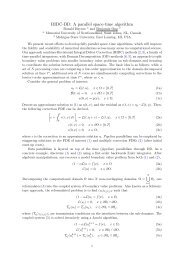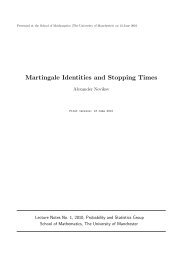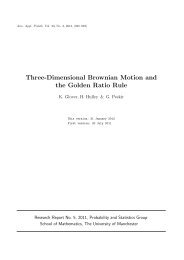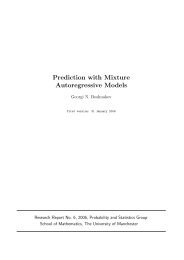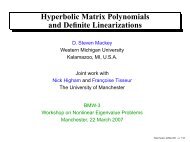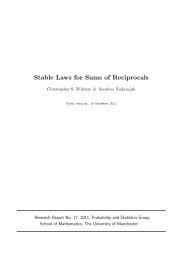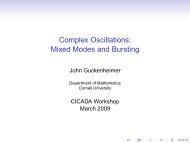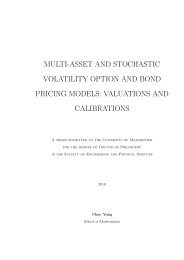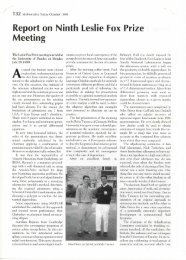Local Behaviour of First Passage Probabilities - MIMS - The ...
Local Behaviour of First Passage Probabilities - MIMS - The ...
Local Behaviour of First Passage Probabilities - MIMS - The ...
Create successful ePaper yourself
Turn your PDF publications into a flip-book with our unique Google optimized e-Paper software.
4 Pro<strong>of</strong> <strong>of</strong> Proposition 12Pro<strong>of</strong>. We will be applying the results in Lemma 10 to formula (17) and wewrite the RHS <strong>of</strong> (17) as P 1 + P 2 + P 3 ; where with 2 (0; 1=2);andP i = X Xg(r; x z)g (n r; y z); 1 i 3;y^xr2A i z=0A 1 = f0 r ng; A 2 = fn < r (1 )ng; and A 3 = f(1 )n < r ng:(i) We introduce d(); an increasing and continuous function which satis…esd(n) = nc n ; and with bc standing for the integer part function, use Lemma 10to writeXy^xP 1 f(0)=bncXz=0 r=0V (y z)g(r; x z)d(n r)y^xbncf(0) X XV (y z) g(r; x z)d(n(1 ))z=0r=0f(0) Xy^xV (y z)[u(x z)d(n(1 ))z=01Xr=bnc+1g(r; xz)]:We can apply Lemma 10 again to get the estimate, uniform for w=c n ! 0;1Xr=bnc+1Since we know thatg(r; w) 1Xr=bnc+1nu(n)lim infn!1 U(n) > 0;f(0)U(w) Cf(0) U(w):rc r(see e.g. <strong>The</strong>orem 8.7.4 in [6]) we see that this is o(u(w)). Also we haveXy^xbncXz=0 r=0V (y z)g(r; x z)d(n r) 1d(n)Xy^xbncXz=0 r=0c ng(r; x z)V (y z);so we see thatd(n)P 1limn; f(0) P y^x= 1; (36)V (y z)u(x z)z=010



